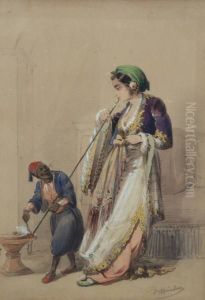Giovanni, Jean Brindesi Paintings
Giovanni Brindesi, commonly known as Jean Brindesi, was a 19th-century artist, primarily known for his detailed lithographs and illustrations that depicted landscapes, urban scenes, and architectural wonders of his time. Born in 1826 in Italy, Brindesi's life and work were emblematic of the period's fascination with travel and the exotic, which was fueled by the increasing ease of transportation and a growing interest in archaeology and oriental studies.
Despite the lack of extensive personal records, Brindesi's artistic contributions are well documented through his works. He traveled extensively throughout the Mediterranean, particularly in the Ottoman Empire, which provided a wealth of inspiration for his art. His works are characterized by their meticulous attention to architectural detail and their ability to capture the atmosphere of the locales he depicted. These qualities made his illustrations valuable to both the artistic community and historians, as they provide a historical record of many locations as they appeared in the 19th century.
Brindesi was most active during the mid to late 19th century, a time when the genre of travel literature was becoming increasingly popular. His illustrations often accompanied texts, serving as a visual guide to far-off places for a European audience that was eager to learn about the world beyond their borders. His lithographs were not only appreciated for their artistic merit but also for their educational value, enabling viewers to glimpse the architectural heritage and daily life in regions such as Greece, Egypt, and the Near East.
One of his most significant contributions was to the illustration of the book 'Égypte et Nubie' by French writer and photographer Maxime Du Camp, which included texts by Gustave Flaubert. Brindesi's images in this work helped to shape the European vision of Egypt and contributed to the period's Egyptomania.
Jean Brindesi's death in 1881 marked the end of a career that had significant influence on the perception of the Eastern Mediterranean and Middle Eastern cultures in Europe. His works remain a testament to the 19th century's interest in other cultures and continue to be studied for their artistic and documentary value.
